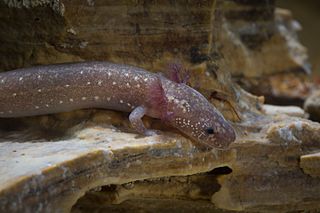
The Barton Springs salamander is an endangered lungless salamander. It is endemic to Texas, United States. It was first found in Barton Springs in Austin, but is now also known from other localities in the nearby Travis and Hays Counties. Barton Springs salamanders are average-sized and have mottled coloration varying from darkish purple to light yellow.
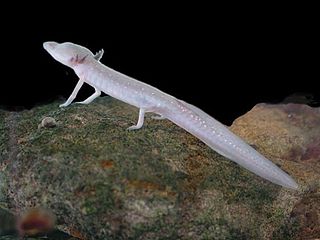
The Texas blind salamander is a rare cave-dwelling troglobite amphibian native to San Marcos, Hays County, Texas, specifically the San Marcos Pool of the Edwards Aquifer. The salamander has blood-red external gills for absorbing oxygen from the water. The salamander's mature length is 13 cm (5 in). Its diet varies by what flows into its cave, including blind shrimp, snails, and amphipods.
The Cascade Caverns salamander, or Cascade Caverns neotenic salamander, is a species of aquatic salamander endemic to Cascade Caverns in Kendall County, Texas. Like other species of cave salamanders, they are almost entirely subterranean, living in spring waters deep in limestone rock strata, so gauging the exact extent of their geographic range or even their population numbers is virtually impossible. This also leads to reduced sampling for study, which has led to some uncertainty in the taxonomic classification; some sources consider all species of Texas cave salamanders to be subspecies of the Texas salamander. Eurycea neotenes and Eurycea rathbuni also live in caves and eat small insects and spiders.
The Valdina Farms salamander is a species of aquatic salamander described from Valdina Farms Sinkhole in Medina County, Texas, United States. It is sometimes referred to as the Valdina blind salamander or sinkhole salamander. As some other species of Eurycea found in Texas, it was once classified as a subspecies of the Texas salamander, Eurycea neotenes, and believed to possibly be the result of hybridization with another species of subterranean salamander, but was granted full species status in 2000. Research is ongoing, and some sources suggest the current species may actually be multiple distinct species.

The San Marcos salamander is a small species of aquatic, lungless salamander native to the United States, endemic to Spring Lake and a small region of the headwaters of the San Marcos River near Aquarena Springs, in Hays County, Texas. It is one to two inches long, with a slender body and external gills, and is a reddish-brown in color.
The Blanco blind salamander is a species of aquatic, lungless salamander native to the United States. It is endemic to a small region of the Blanco River near San Marcos in Hays County, Texas. Its habitat, deep in limestone karst, makes collecting specimens for research particularly problematic. It is known from only a single specimen, collected in the 1950s.
Eurycea neotenes, also known as the Texas salamander, Bexar County salamander, Edwards Plateau salamander, or Texas neotenic salamander, is a species of entirely aquatic, lungless salamander native to the United States. It is endemic to central Texas, near Helotes, in Bexar County.

The northern two-lined salamander is a species of salamander in the family Plethodontidae found in Canada and the United States. Its natural habitats are temperate forests, temperate shrubland, rivers, intermittent rivers, freshwater marshes, freshwater springs, arable land, and urban areas. It is more water-oriented than the related northern redback salamander, and can often be found in and around water such as rain puddles, streams, swamps, and damp stream beds, whereas the northern redback tends to be found in damp ground, but usually not near open water.
The Salado Springs salamander is a species of salamander in the family Plethodontidae. It is endemic to the vicinity of Salado, Texas.

The southern two-lined salamander is a species of salamander in the family Plethodontidae, endemic to the United States. Its natural habitats are temperate forests, rivers, intermittent rivers, swamps, and freshwater springs.

The Georgetown salamander, also known as the San Gabriel Springs salamander, is a species of salamander in the family Plethodontidae. It is endemic to springs in Williamson County, Texas, near Lake Georgetown. It inhabits freshwater springs and, possibly, caves. It is threatened by habitat loss. Many of the springs where this species formerly lived have been destroyed by development, including creation of Lake Georgetown. The specific name refers to the few remaining remnants of habitat for this species.
The fern bank salamander, also known as the Blanco River Springs salamander, is a species of salamander in the family Plethodontidae. It is endemic to springs in the Blanco River watershed in central Texas, United States.
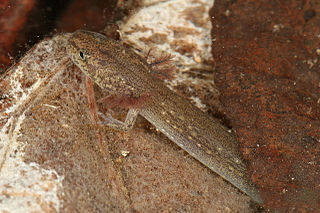
The Jollyville Plateau salamander is a species of salamander in the family Plethodontidae. It is also known as the Tonkawa Springs salamander. It is endemic to Travis and Williamson counties, Texas, United States. This species is perrenibranchiate, retaining its gills throughout life.
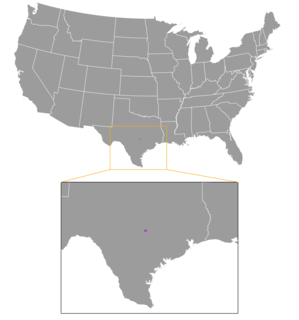
The Austin blind salamander is an endangered species of salamander in the family Plethodontidae, endemic to Barton Springs in Austin, Texas, United States. Its name is derived from Waterloo, the original name of Austin.

The grotto salamander, also called the Ozark blind salamander, is a species of salamander in the family Plethodontidae. It is now considered a member of the genus Eurycea, but was originally described as Typhlotriton speleus. It is endemic to the United States, specifically the karst regions beneath the Springfield and Salem Plateaus of the Ozark Mountains part of Arkansas, Kansas, Missouri, and Oklahoma. Its natural habitats are freshwater springs, inland karsts, and caves. It is not currently threatened, but vulnerable to changes in groundwater quality and reduction in bat population.
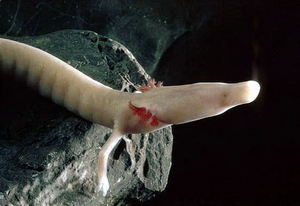
A cave salamander is a type of salamander that primarily or exclusively inhabits caves, a group that includes several species. Some of these animals have developed special, even extreme, adaptations to their subterranean environments. Some species have only rudimentary eyes. Others lack pigmentation, rendering them a pale yellowish or pinkish color.










